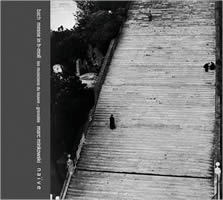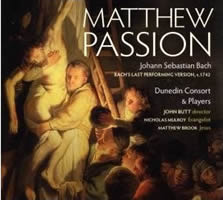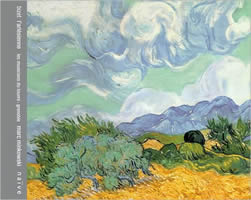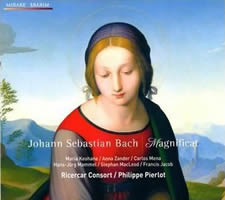Trois Bachs et un Bizet
|
Dan Albertson [February 2010.] [Mit Dank an Monica Bonvicini für die Tatsache, daß ich jetzt fast ein Blinde bin! For Raoul Basa, in friendship and with gratitude for, inter alia, his help in reawakening my compulsion to write. You, too, must return to the craft! Per Philip Larkin, “… and what it held / Stood ready to be loosed with all the power / That being changed can give.” Hell, I could not resist “The Whitsun Weddings.” Who could? Raoul likely joins me in remembering Mary Daly, a woman feisty enough to have been single-handedly able to bring back the castrato, if she could have. D.A.]
Johann Sebastian BACH: Messe h-moll, BWV 232 (1724-49). Lucy Crowe & Joanne Lunn (sop I), Julia Lezhneva & Blandine Staskiewicz (sop II), Nathalie Stutzmann & Terry Wey (alt), Colin Balzer & Markus Brutscher (ten), Christian Immler & Luca Tittoto (bass), Les Musiciens du Louvre-Grenoble, Marc Minkowski (dir.). Naïve V 5145 (http://www.naive.fr/). Distributed in the US by Naxos (http://www.naxos.com/). Marc Minkowski, once the rising hope of French early music, is nearing 50, and has a new label, Naïve, after more than a decade with Archiv. Had his amour for Gluck soured that relationship, one wonders? The new discs are impressive, further proof that he was not meant to toil away as a bassoonist for long. His Bach mass is ernst, as the stark cover image immediately reinforces, and almost sunless at times. Where is the Lutheran levity? Other than Händel and Offenbach, who only half count, Minkowski had avoided German répertoire until now, a topic he treats in a useful conversation with Rémy Louis. Another text, by the noted George B. Stauffer, fills in some information for the uninitiated. The Minkowski account, from 7/08, is persuasive, while employing the bare minimum of singers. To his 10 voices he adds an orchestra of 26, including both organ and harpsichord, to my delight. His tempi are more moderate than those of Junghänel (2/03), his main competitor — and who could have imagined that? Indeed, Minkowski is closer in pacing to Gardiner (2/85), Herreweghe I (4/88, on which he himself plays) and Herreweghe II (7/96), in the 105- to 110-min. range. Junghänel, with a mere 19 musicians and sans harpsichord, almost breaks the century mark. In general, the solo and duet sections are the strong suits, with the choral numbers underwhelming; after the 18-min. Kyrie, I was increasingly less sure. Cantus Cölln fares better in that respect, but less well in the solos. No one could win on every level. Minkowski may suffer from the drab acoustic of the San Domingos de Bonaval church in Santiago de Compostela, or the veteran producer Jean-Pierre Loisil, or both. Special praise must go, as usual, to Stutzmann, whose Agnus Dei is as sobering as any on disc, and to Crowe and Wey for the fine Et in unum Dominum. Tittoto and hornist Johannes Hinterholzer handle the Quoniam tu solus sanctus with assurance. Lezhneva survives her only solo, Laudamus te, in partnership with violinist Thibault Noally, but is far from distinctive. The transverse flute of Florian Cousin proves quite effective in Domine Deus, with Lunn and Brutscher, and in Benedictus with Balzer. To return to Lezhneva for a moment: A biography beginning “Julia Lezhneva was born in 1989” is sure to make any of us feel old. A Bach series is promised from Minkowski; more cantatas and passions* are probably not needed, but if the quality stays high, I will be aboard for that journey.
Johann Sebastian BACH: Matthäus-Passion, BWV 244 (Bach’s last performing version, ca. 1742) (BWV rendered as “BMV” on back cover). Susan Hamilton & Cecilia Osmond (sop), Annie Gill & Clare Wilkinson (alt), Malcolm Bennett (ten), Nicholas Mulroy (Evangelist), Brian Bannatyne-Scott (bass), Matthew Brook (Jesus); other voices: Frances Cooper & Ali Darragh (sop), Roderick Bryce & Michael Wallace (bass), Dunedin Consort & Players, John Butt (dir.). Linn Records CKD 313 (http://www.linnrecords.com/). Distributed in the US by Spinning Dog Records (http://www.spinningdogrecords.com/). *On that very subject comes this Passion from Scotland’s enterprising Dunedin Consort. As with the group’s The Messiah, here is a Passion with a difference. Following the lead of McCreesh and his controversial Passion, Butt and crew use one-per-part voicing, but here with cameos by ancillary singers for the smaller rôles encountered along the way. Butt thus employs 12 voices to McCreesh’s nine; the latter’s only concession is the opening soprano in ripieno. No Passion will capture all that is sought; one will find no bombast here and traditionalists will think it too fast and too threadbare. Those qualities, in conjunction with the clear, direct and emotive singing, endear this effort to me. Many of the singers are graduates of what one could call the “Gardiner pilgrimage.” “Geduld,” already a dark aria, is even darker here and quite striking. The weaker moments include interjections that are rather timid in the opening chorus, though I prefer such understatement to overblown theatricality à la Harnoncourt, and the lack of a continuo ostinato in “Erbarme Dich, mein Gott,” which seems too airy without such grounding. McCreesh’s eight voices also handle “Sind Blitze, sind Donner” with more conviction than Butt’s octet. The differences in the performing edition are slight enough, and good enough, never to detract, though the opening chorus with a prominent harpsichord was a shock at first. A warning about the CD sounding better through a Linn CD player is advice I could not heed. A synesthete will find that the Rembrandt cover sounds nice on any CD player, though. Or not.
Georges BIZET: Carmen (Prélude & 3 entr’actes) (1873-74); L’Arlésienne: Suite No. 1 (arr. Bizet) (1872), musique de scène*, Suite No. 2 (arr. Ernest Guiraud) (1879). Chœur de l’Opéra de Lyon*, Alan Woodbridge (dir.)*, Les Musiciens du Louvre-Grenoble, Marc Minkowski (dir.). Naïve V 5130 (http://www.naive.fr/), available as a CD or as a CD-livre with images by Vincent van Gogh, Paul Gauguin, Francis Bacon and Joan Mitchell. Distributed in the US by Naxos (http://www.naxos.com/). Bizet is far from my Fach, but the Minkowski performances seem passionate, yielding a pleasant hour of diversion. The recording is somewhat bottom-heavy, however, with the famous triangle in the Prélude to Carmen rendered completely inaudible, for instance. The blame there would go to Loisil for sure this time. Carmen snippets abound, so the major attraction is, I would guess, the selection of incidental music to Alphonse Daudet’s L’Arlésienne in its original orchestration. All the music is charming and just in its fame; the instrumental colors are striking, with the saxophone and two cornets making compelling cases for more frequent inclusion. The Farandole that ends the second suite is given both with and without chorus. The CD-livre edition is wondrous, though the choice of artwork is completely puzzling. Which thread would unite Van Gogh or Gauguin to Bacon or Mitchell, or indeed to Bizet? Fortunately for me, I need not worry: LF is a music journal, oui?
Johann Sebastian BACH: Magnificat, BWV 243 (1732-35); Fuga sopra il Magnificat, BWV 733 (1708-17); Missa, BWV 235 (1735-40?); Präludium und Fuga in G, BWV 541 (1708-17). Maria Keohane & Anna Zander (sop), Carlos Mena (alt), Hans Jörg Mammel (ten), Stephan MacLeod (bass), Francis Jacob (org), Ricercar Consort, Philippe Pierlot (dir.). Mirare MIR 102, CD + DVD by Pierre-Hubert Martin (http://www.mirare.fr/). Distributed in the US by Harmonia Mundi (http://www.harmoniamundi.com/). To begin, here is a morsel from the institution known to us at LF, following Walt’s lead, as Grampsophone: “… there will be some who consider his tempos too much on the brisk side” (9/85). Gardiner is the “his” here. Keep these paroles in mind. The arrival of Pierlot (4/09), and my enthusiasm for it, gave me a wild idea. I spent a Sunday with the Mag, trolling my vaults and finding four editions: Gardiner (11/83), Parrott (4/89), Herreweghe (1/90) and McCreesh (4/00). I excluded Herreweghe’s later account of the German Mag, for obvious reasons. I listened to these discs in a row, an exercise best not repeated. Gardiner (Argenta / Kwella / Brett / Rolfe Johnson / Thomas) could be discounted easily; his trumpets and timpani are far too pompous, not alien to the music, but alien to my sensibilities. His choir of 20-25 is also too large to cope with the swings of this music. I marvel at the obvious jubilation, though, and his tempi are now standard. Parrott (Van Evera / Tubb / Trevor / Crook / Grant) is a keeper, even now; the singing is not as polished as one expects today, but the instrumental-vocal balance is superb and the suite of 12 movements holds together with ease. Herreweghe (Schlick / Mellon / Lesne / Crook / Kooij), I am pained to write, seems dutiful at best. His tempi are quite slow compared to Gardiner, and indeed to the other four editions surveyed, and the music seems mired in the terra firma instead of ascending toward the cœli. His choir, of similar proportions, fares no better than Gardiner’s, but his soli are the starriest of the bunch. The yeoman Roy Goodman, a second violinist for Gardiner, is Herreweghe’s concertmaster here. McCreesh (McCord / Gooding / Blaze / Agnew / Davies) has the opposite problem, with acrobatics galore, but no real verve. The music is dispatched, not performed. The real wonder of the recording is that the singers are able to keep up with McCreesh’s pace, which borders on the insane. His German parish-organ in the bass aria Quia fecit mihi magna is a delight, however, that no other recording comes close to replicating. Now to Pierlot, whose durations are identical to Gardiner’s, but whose musicians are blended better, without the air of Handelian pomp. His singers are much richer in ornamentation than the competition, leaving no doubt of their intuition and imagination. The concomitant missa brevis is convincing and the organ interlude and postlude make for fine programming, as well. As a concept and as a series of individual performances, this disc recommends itself. The DVD is sometimes disorienting, but is a useful reminder of how intense and, yes, disorienting the recording process is. The “Ricercar roll” continues. Pierlot’s reading is one for our time. I would be reluctant to leave behind Parrott, but Pierlot must go to the top of the pile if a blithe and lithe Mag is what one is seeking. If not, watch this space, because Walt will have a gem for you.
[More Dan Albertson]
[Previous Article:
Second Appeal for Support for IMEB]
[Next Article:
Album Tweets 7.]
|



